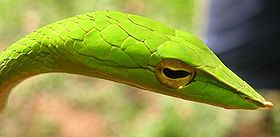
Back Schlangenbeschuppung German Escamas de las serpientes Spanish Mao soomused Estonian پولک مار Persian Sisik ular ID ヘビの鱗 Japanese ಹಾವಿನ ಪೊರೆ Kannada பாம்புச் செதில்கள் Tamil 蛇鳞 Chinese


Snakes, like other reptiles, have skin covered in scales.[1] Snakes are entirely covered with scales or scutes of various shapes and sizes, known as snakeskin as a whole. A scale protects the body of the snake, aids it in locomotion, allows moisture to be retained within, alters the surface characteristics such as roughness to aid in camouflage, and in some cases even aids in prey capture (such as Acrochordus). The simple or complex colouration patterns (which help in camouflage and anti-predator display) are a property of the underlying skin, but the folded nature of scaled skin allows bright skin to be concealed between scales then revealed in order to startle predators.
Scales have been modified over time to serve other functions such as "eyelash" fringes, and protective covers for the eyes[2] with the most distinctive modification being the rattle of the North American rattlesnakes.
Snakes periodically moult their scaly skins and acquire new ones. This permits replacement of old worn out skin, disposal of parasites and is thought to allow the snake to grow. The arrangement of scales is used to identify snake species.
Snakes have been part and parcel of culture and religion. Vivid scale patterns have been thought to have influenced early art. The use of snake-skin in manufacture of purses, apparel and other articles led to large-scale killing of snakes, giving rise to advocacy for use of artificial snake-skin. Snake scales are also to be found as motifs in fiction, art and films.
- ^ Boulenger, George A. 1890 The Fauna of British India. p. 1
- ^ The Snakes of Indiana Archived 2012-04-19 at the Wayback Machine at The Centre for Reptile and Amphibian Conservation and Management, Indiana. Retrieved 14 August 2006.